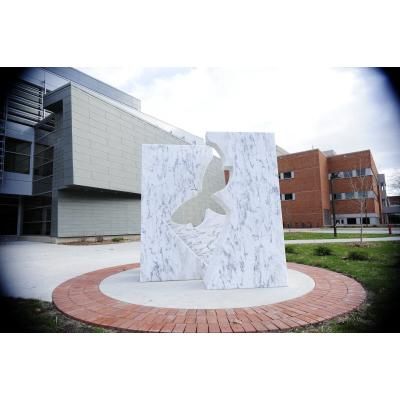The Moth illustrates department of computer engineering
March 10, 2016
Three solitary fragments of smooth, white marble rise from the barren ground, seemingly insignificant until they’re seen from the perfect angle.
Settled before Iowa State’s Coover Hall, The Moth, a sculpture by Mac Adams and commissioned by Iowa State, represents the computer engineering department.
On Sept. 9, 1947, a computer at Harvard University crashed when a moth flew into an electrical circuit of the machine and caused the system to malfunction.
“When scientists peeled the fried insect off of the hardware, they coined the term ‘debug,’” said Lynette Pohlman, director of Iowa State’s University Museums.
Inspired by the fascinating story, Adams designed what is now a well-known work of art on campus.
“I see it as iconic,” Pohlman said. “I love that it is fanciful, narrative and abstract, yet it has humor.”
Campus is void of human activity, and a fresh blanket of snow covers The Moth, which sprouts blindly from the frosted land. The scene is immaculate, Pohlman said while tearing up as she considered the beauty of The Moth.
The piece uses perspective and light to share its narrative, she said. With each passing minute, hour, day or year, the image of The Moth changes slightly, implying that everything changes with time.
The image of The Moth is also different from different angles, similar to how people react to various challenges in their life as they grow older and wiser.
The design of the Moth underwent careful consideration from its creator, Adams. Because the sculpture needed to convey the values of the computer engineering department and relate to other students, Adams conducted careful research before beginning his project.
Under the Art in State Buildings program, .5 percent of the construction costs of a new building is used to commission art for the area.
Art committees are selected for each building, and the committee must work together to create a proposal, find an artist, approve a budget and install the art.
Once an artist is selected, he or she works with the department to explore its values and begin to develop ideas.
Adams was selected to create a piece for this space based on his strong use of light and shadow and his impressive work with abstraction.
“A work of art is only complete when it is understood,” said Dave Faux, interpretation specialist with University Museums.
Similar to the process in which the scientists went about finding the source of the computer’s problem, passersby must examine The Moth to discover what it is.
The Moth’s pieces carry a larger meaning than simply implying that the moth was pulled out of the computer in several pieces. The sculpture is intended to help viewers understand the complexity of life.
“Art that is well done will create a reaction,” said Nancy Gebhart, director of art education and visual literacy for University Museums.
“We’re never going to appeal to everyone’s taste of art,” Gebhart said.
When Iowa State was established in 1858, it was created to be a beautiful and inspiring learning environment. Iowa State’s Art on Campus collection aims to inspire students to learn and create.
Iowa State has an extensive collection of public art, with more than 2,000 pieces on display or in storage. Gebhart said The Moth is one of the most popular pieces of art on campus.
Taking time to appreciate works of art improves critical thinking, communication skills and improves the comprehension of any curriculum, Pohlman said.
“We’re a very serious place; we don’t play very well, and yet I think playfulness and creativity are almost synonymous,” Pohlman said. “I think that playing is where great ideas pop up.”
Just as the scientists at Iowa State struggled in their research to create the first computer, students must work each and every day to challenge themselves in order to appreciate and learn about works of art like The Moth.







